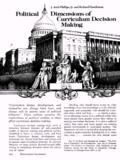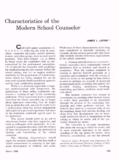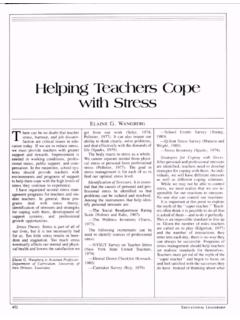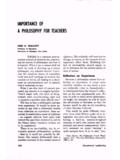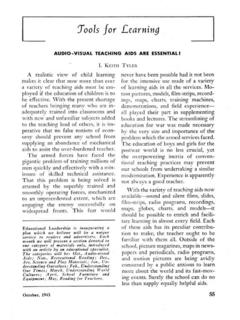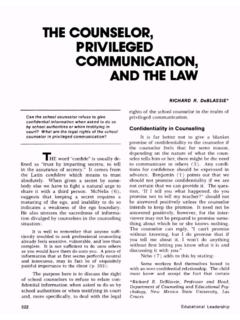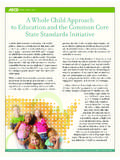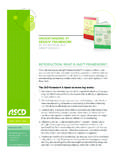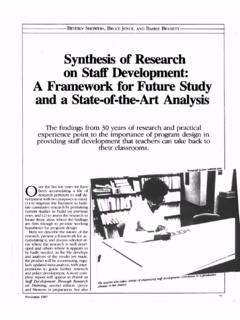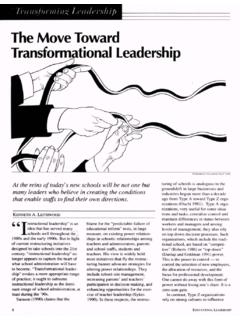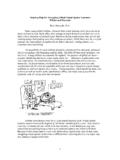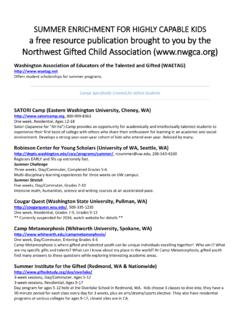Transcription of Key Features of Successful Programs for the Gifted …
1 Key Featuresof SuccessfulPrograms for theGifted and TalentedSALLY M. REIS AND JOSEPH S. RENZULLIO utstanding giftedprograms reflectthe special qualitiesof the people andschools involved,but have manycharacteristics the past fie yecars we havcexperimented with a rici pro-gram for Gifted and talented stu-dents that has been used successfully inseveral school locations and under avariety of conditions (Renzulli, and Rcnzulli. 1982, Dclisle andRenzulli, 1981; Delisle, Reis, and Gub-bins, 1981). At present, we are monitor-ing the model in over 30 school districtsin Triad/RDIM ProgramThe system combines the EnrichmentTriad Model (Rcnzulli, 1977) with arelatively ncw, plan for identification,the Revolving Door Identification Model(RDIM) (Renzulli, Reis, and Smith.,1981). Although several specific learn-ing objectives arc built into these comi-bined models, this article focuses on themodel's general program goals.
2 E-signed to integrate a program for gifted_A ITSally M. Reis is Coordinator, Programsfor the Gifted and Talented, Torrington,Connecticut, Public Schools; and JosephS. Renzulli is Associate Director, Bu-reau of Educational Research, and Pro-fessor of Educational Psychology, Uni-versity of Connecticut, LEADERSHIP28students with regular classroom instruc-tion, the model provides enrichmentactivities to a broader spectrum of theschool population than the usual 3 to 5percent of students identified as extending enrichment activities tomore students, the approach minimizesconcerns about elitism and negative atti-tudes toward Gifted Programs , resultingin a general "radiation of excellence"(Ward, 1981) throughout the Enrichment Triad Model, con-sidered to be the nation's most widelyused program for the Gifted and talented(Mitchell, 1981), delineates three typesof enrichment activities for students.
3 * General Exploratory Activities(Type I) consist of experiences and activ-ities designed to put learners in touchwith areas of personal interest. Studentsinvolved in Type I experiences are en-couraged to further explore these areasof interest and can decide to do furtherresearch on the topic or problem theyhave selected.* Group Training Activities (Type II)consist of materials, methods, and in-structional techniques designed to de-velop high level thinking and feelingprocesses: critical thinking, problemsolving, reflective thinking, inquirytraining, divergent thinking, awarenessdevelopment, and creative or productivethinking.* Individual or Small Group Investi-gations (Type III) provide students withopportunities to investigate a real prob-lem or topic by using appropriate inqui-ry methods. Successful completion de-pends on the interest and taskcommitment of individual 111II activities ask students to thinkand feel like practicing in our Programs completedmany intensive, long-range Type I1lprojects including creation of a walkingrobot, a year-long investigation of theeffects of acid rain on northwesternConnecticut, and the production of aweekly children's television Revolving Door IdentificationModel identifies a pool of approximately15 to 20 percent of the student popula-tion.
4 These well-above-average studentsare exposed to Type I activities andreceive Type 11 process training on aregular basis. Periodically, all studentsare offered Type I and I1 enrichmentactivities. Many students whose interestsare generated through Type I or Type IItraining, or through the regular curricu-lum or the environment in general, willeventually "revolve into" the challeng-ing, optional Type III investigationswhen they show an interest and a desireto pursue advanced ProgramsA major goal in developing the modelwas to provide a system to purposefullytake into consideration each district'slocal resources, strengths, budgetaryconstraints, problems, personalities,scheduling procedures, and other idio-syncracies. For example, a plan forinservice training may be highly effec-tive in a district that has the benefit ofstrong administrative support, but a fail-ure in another district where administra-"Studentscreated awalking robot,investigated theeffects of acidrain, andproduced aweeklychildren'stelevisionprogram.
5 "APRIL 198429"A thoroughunderstandingof the modelprovideseveryone with acommonlanguage foreffectivecommunication."tive support for Gifted programming isabsent. Evecr Gifted program should becarefully planned swith an individualdistrict in key Features that tend to makesome Gifted Programs more effectivethan others have emerged from ourresearch and close interaction with thevarious field districts. Every feature re-lates to variables that can be changedthrough careful orientation, staff devel-opment, and the appropriate use ofbuilt-in monitoring and feedback; andall can be replicated in any school'sgifted program through careful planningand specific program monitoring feature 1: The Golden RuleThe golden rule simply states that themore thoroughly the instructional staff,students, parents, and administrationunderstand the overall structure of themodel, the easier it is to implement aparticular identification procedure orlearning activith.
6 Orientation sessions,written materials, and visual displayshelp all participants to understand thegeneral and particular functions of allaspects of the model and each person'sunique role in carrying out these "golden rule" presents a greatopportunity for creativity on the part ofteachers and students. In some districts,students have developed movies or slide/tape presentations explaining the pro-gram. In other districts, bulletin boardsin prime locations display the model insimple, eye-catching graphics, whichmake it easily understood by even theyoungest thorough understanding of themodel provides everyone with a com-mon language for effective communica-tion. It enables us, for example, toinform a parent that his or her childrevolved into a Type III activity onfilmmaking as a result of a Type Ipresentation by a local cinematogra-pher. Students must also understand theplanned, purposeful connections be-tween Type I, II, and III activities.
7 Theyneed to be aware that the purpose of acinematography presentation is to stim-ulate new interests and ideas, and thatthe model provides advanced level fol-low-up (Type III111) activities that willemphasize creative and productive the language of themodel also aids in planning and orga-nizing activities according to their cate-gorical function, emphasizing the pur-pose of particular staff developmentsessions, and allocating time and moneyfor each major type of reports are more easily pre-pared and understood when everyoneinvolved has a common understandingof all program components and theinterrelated role they play in the feature 2: Planning Prior toProgram ImplementationA frequently cited reason for the successof Triad/RDIM Programs is the carefulplanning that occurred prior to imple-mentation. In each district a planningteam was established to make decisionsabout how the model would be tailoredto accommodate the unique characteris-tics and resources of each participatingschool.
8 The planning team (which con-sisted of both volunteers and personsselected by administrators) includedclassroom teachers, school psycholo-gists, media specialists (when available),parents, principals, and central officeadministrators. Quite often the teamalso included a faculty member whohad been an outspoken critic of giftedprogramming. Appointing outspokenand negative facult'. members to a plan-ning team can divert negative energyinto a more positive channnel, therebyeliminating potential principal functions of the plan-ning team are to determine the gradelevels to be included in the program, thesize of the talent pool, and the criteria tobe used for forming the talent pool. Theteam also selects methods for trainingclassroom teachers in nomination pro-cedures and for planning further inser-vice and orientation for teachers andparents. By carefully determining dur-ing the spring before implementationwhich grade levels are to be involvedand how they are to be selected, studentnominations may be completed by staffmembers who have had nearly a com-plete academic year to become ac-quainted with their students' strengthsand several of our research districts,parents of students who had been in-volved in traditional Gifted programswere invited to a meeting designed toexplain the differences between tradi-tional programming and carefully addressing the concerns ofparents (such as expanding the currentgifted program to involve 15 to 20 per-cent of the student population), educa-tors can resolve problems of misunder-standing before implementing feature 3.
9 Inservice andAdministrative SupportFor any new program to be Successful ,carefully organized inservice trainingmust be provided for all persons whowill be involved. In our experience, themost Successful Programs includedschool administrators in the inservicetraining. Principals need to know howto answer basic structural questionsabout the program. They should under-stand the major categories of serviceavailable to talent pool students withouthaving to know the specific details. Alladministrative and instructional staffshould be able to explain the maincomponents of the program to parentsand to answer basic questions. Manycomplaints about Gifted Programs stemfrom the frustrations experienced whenteachers and administrators are unableto answer a types of inservice should beused to familiarize faculth and adminis-trators with Triad/RDIM. Formal inser-vice, which most teachers are familiarwith, consists of short sessions focusingon specific topics and skills related to theprogram's implementation.
10 At leastthree formal inservice sessions should bescheduled and each should address aspecific topic. Sequential subjects to becovered include a detailed structuraloverview of the entire system; a defini-tion of giftedness and resulting identifi-cation procedures; the specific roles andresponsibilities of classroom and re-source teachers; and, finally, an in-depth session on compacting or stream-lining the regular curriculum to ensurethat students have an adequate chal-lenge in the regular classroom as well asthe time to participate in the inservice refers to the regu-lar interactions that any teacher of thegifted will have with other staff mem-bers, parents, or community inservice consists of the posi-tive program reinforcement that teach-ers of the Gifted communicate throughconversations with other staff conversations mav occur in thehallway, the cafeteria, or the teachers'lounge.
